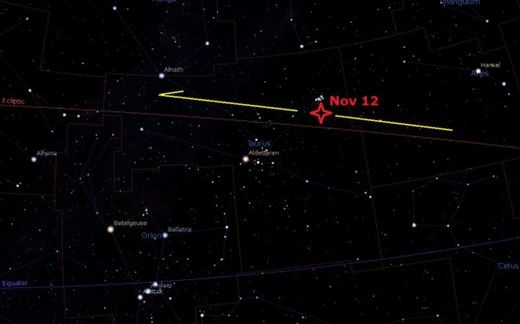The motion of the radiant of the Northern Taurid meteors from mid-October through mid-November.
The shower typically peaks around November 12th annually.
Specifics for 2015
This year sees the Moon reaching Full on Tuesday October 27th, just a few days before Halloween. The Taurid fireballs, however, have a few things going for them that most other showers don't. First is implied in the name: the Northern Taurids, though typically exhibiting a low zenithal hourly rate of around 5 to 10, are, well, fireballs, and thus the light-polluting Moon won't pose much of a problem. Secondly, the Taurid meteor stream is approaching the Earth almost directly from behind, meaning that unlike a majority of meteor showers, the Taurids are just as strong in the early evening as the post midnight early morning hours. As a matter of fact, we saw a brilliant Taurid just last night from light-polluted West Palm Beach in Florida, just opposite to the Full Moon and a partially cloudy sky.
In stark contrast to the swift-moving Orionids from earlier this month, expect the Taurid fireballs to trace a brilliant and leisurely slow path across the night sky, moving at a stately 28 kilometre per second (we say stately, as the October Orionids smash into our atmosphere at over twice that speed!).

A 2013 Taurid fireball captured by an All-Sky cam, plus a near-Full Moon.
Ever since the 2005 event, the Northern Taurids seemed to have earned the name as "The Halloween Fireballs" in the meme factory that is the internet. It's certainly fitting that Halloween should have its very own pseudo-apocalyptic shower. The last good return for the Northern Taurids was 2005-2008, and 2015 may see an upswing in activity as well.
Obviously, something interesting has to be occurring on Comet 2P Encke—the source of the two Taurid meteor streams—to shed the pea-sized versus dust-sized material seen in the Southern and Northern Taurids. With the shortest orbital period 3.3 years of all periodic comets known, the Taurid meteor stream—like Encke itself—follows a shallow path nearly parallel to the ecliptic plane.
Discovered in 1822 by astronomer Johann Encke, Comet 2P Encke has been observed through many perihelion passages over the last few centuries, and passes close to Earth once 33 years, as it last did in 2013.
Read more here.

 RSS Feed
RSS Feed